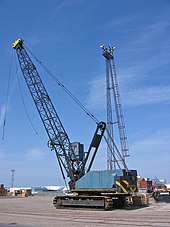Priestman Brothers
| Industry | Engineering |
|---|---|
| Founded | 1870 |
| Founder | William Dent Priestman,Samuel Priestman |
| Headquarters | , England |
| Products | Excavators, cranes,dredgingmachinery |
Priestman Brotherswas an engineering company based inKingston upon Hull,England that manufactured diggers, dredgers, cranes and other industrial machinery. In the later 1800s the company also produced thePriestman Oil Engine,an early design of oil fuelled internal combustion engine.
History
[edit]Priestman family ownership (1870–1895)
[edit]The company was founded in 1870;[1]William Dent Priestmanbought the Holderness Foundry with money from his father, a Leeds corn-miller. William's brother Samuel also joined the company.[2]
It is said the company's entry into the construction of dredging equipment began in 1876 when they were asked to construct machinery to recover lost gold from the sea west of the coast of Spain. No gold was found but the company's equipment proved useful for dredging of harbours and docks;[3]the company pioneered the manufacture of steam powered cranes with grab (clamshell) buckets.[4]
From 1888 to 1904 the company produced various versions of thePriestman Oil Engine,an early example of an internal combustion engine.[5]Models were produced with engine power from 2 hp (1.5 kW) up to 60 hp (45 kW) for a double cylindered version. The company opened a factory inPhiladelphia(USA) in 1892, also producing engines.[2]In 1894 the company produced one of the earliest recorded examples of an internal combustion engine for railway, based on an 1888 prototype – the 20 h.p. two axle machine was tested on theHull Docks.[6][7][8][9]
In 1895 bad debts and a decline in sales made the company insolvent, the business was reformed but William and Samuel lost their seats on the board.[2]
Public ownership (1895–)
[edit]
The company was reformed and began business again; after theFirst World Warits products were used in the rebuilding of French villages, in 1921 a machine for digging field drainage drains was produced and the company received investment from theMinistry of Agriculture.[3]
The company constructed a factory inMarfleet,Hullin 1950, which eventually covered 63 acres (250,000 m2).[3]
In 1928 production of excavators named after animals began; models named "Lion", "Tiger" and "Panther" were produced.[3]
The company merged withColes Cranesof Sunderland in 1970.[10]
In 1972 the Steels Group, Priestman's parent company, was taken over by the Acrow Group.[11]
The Priestman division was sold off in 1984 and was eventually merged with Coles Cranes. The remnants of the company are owned byGardner Denver,and it no longer supports the Priestman range of products.
The Priestman Grab & VC Excavators Divisions were sold toRB International,this business continues to be supported byDelden Cranes Ltd,through their RB Cranes Division.[12]
References
[edit]- ^"Priestman Brothers".Grace's Guide (The Best of British Engineering 1750–1960s).Retrieved24 January2013.
- ^abc"Priestman, William Dent".Biographical Dictionary of the History of Technology.Taylor and Francis. 27 June 2003.ISBN0-203-02829-5.Archived fromthe originalon 26 August 2010.
- ^abcdMark, Dave (30 August 2005)."Display tells story of iconic city company".Yorkshire Post.Retrieved24 January2013.
- ^Manktelow, Peter (2001).Steam Shovels.Osprey Publishing. p. 29.ISBN0747804834.
- ^"Priestman oil engine built in 1895, on display at the Science Museum, c 1990".Ingenious.National Museum of Science and Industry.Retrieved24 January2013.
- ^Diesel Railway Traction,vol. 17, p. 25, 1963,
In one sense a dock authority was the earliest user of an oil-engined locomotive, for it was at the Hull docks of the North Eastern Railway that the Priestman locomotive put in its short period of service in 1894
{{citation}}:Missing or empty|title=(help) - ^Day, John R.; Cooper, Basil Knowlman (1960).railway Locomotives.Frederick Muller. p. 42.
The diesel has quite a long history, and the first one ran as far back as 1894. This was a tiny 30-h.p. two-axle standard-gauge locomotive with a two-cylinder engine designed by William Dent Priestman
- ^"Motive power for British Railways"(PDF).The Engineer.202:254. 24 April 1956.
- ^Thomson, William (4 May 1888). "Priestmans' Petroleum Engine".The Electrical Review.22:474.hdl:2027/mdp.39015084630964– via Haithi Trust.
A small double cylinder engine has been mounted upon a truck, which is worked on a temporary line of rails, in order to show the adaptation of a petroleum engine for locomotive purposes, on tramways
- ^"The Priestman Story".History of Coles Cranes of Sunderland.Archived fromthe originalon 30 January 2013.Retrieved24 January2013.
- ^"Acrow (Engineers)".Grace's Guide (The Best of British Engineering 1750–1960s.Retrieved24 January2013.
- ^"RB Cranes – Crane Hire and Spare Parts".Retrieved17 April2015.
- Defunct manufacturing companies of the United Kingdom
- Manufacturing companies established in 1870
- Agricultural machinery manufacturers of the United Kingdom
- Defunct companies of Kingston upon Hull
- Crane manufacturers
- 1870 establishments in England
- Construction equipment manufacturers of the United Kingdom
